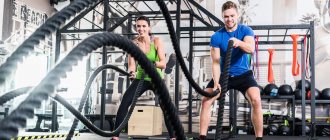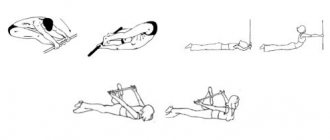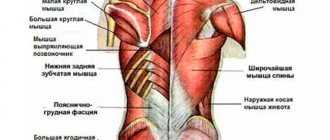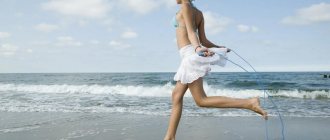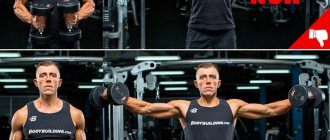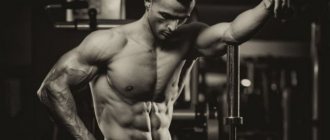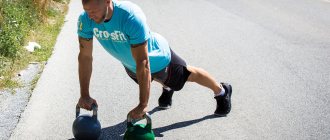General recommendations
In order for calf exercises at home to be as effective, productive and safe as possible, it is important to follow medical recommendations:
- Before starting tasks, warm up your muscles and joints with your hands using rubbing massage movements.
- When moving (during exercise), try to maintain the maximum amplitude.
- The load should be varied, just like the exercises, in order to prevent addiction, which reduces the effectiveness of training for the muscles.
- When doing calf raises, try to place most of your weight on your big toes, not your heels. This will contribute to the rapid and high-quality development of muscle mass.
- Avoid overload. It is recommended to do exercises for the calf muscles no more than 3 times a week so that the muscle fibers have time to recover. Increase the load on the muscles gradually, since their overstrain is fraught with unpleasant consequences, convulsive syndrome.
- During exercise, keep your back straight, watch your posture and breathing.
- After completing the main set of exercises, you should definitely stretch your lower leg muscles. To do this, just step back, fix your heel on the floor and tilt your torso forward.
- Exercises for the muscles of the lower extremities should be performed smoothly, slowly, avoiding jerks and sudden movements.
- The main load should be placed on the soleus muscle and the peroneus longus - these groups are responsible for the slimness of the legs, their fit and attractiveness.
How to pump up your calves

Pumped up calf muscles look beautiful. It takes quite a lot of effort to pump them up. The difficulty of working out this group of muscles lies in the fact that they are involved in everyday life, and, therefore, are accustomed to the constant loads that fall on the legs while walking. Therefore, it is very important to select the most effective and efficient exercises.
Of course, it is best to train in a gym , where there is all the necessary equipment and sports equipment. However, there are equally effective exercises that, with patience, allow you to achieve your goal at home . The main thing is to devote enough time and attention to training, but within reasonable limits, avoiding overtraining and overload. If the load is too heavy, the calves begin to hurt. This signals the need to reduce the intensity. The correctness of training is indicated by a feeling of fatigue and burning. There shouldn't be any pain.
There is no need to question the fact that weak and thin legs do not make a man look good, especially if he has a pumped and powerful torso. Such a disproportion looks quite comical. An athlete’s figure looks completely different if the legs are well designed and have an attractive relief. And to achieve this, you need to properly and competently organize the training of the calf muscles. This can be done by having a clear understanding of how this muscle works.
Warming up and stretching
Before performing exercises for the calf muscles, pre-warming and stretching are required, which will increase the effectiveness of the training and help avoid traumatic injuries and micro-tears.
To warm up, you can use the self-massage technique. Rub the area of the ankle, ankle, foot.
The following types of exercises are suitable for stretching:
- One leg swing. Lean against the wall, the back of the chair, place 1 limb on the floor, and swing the 2nd limb, trying to raise it as high as possible. The recommended number of repetitions is 15 times for each leg.
- Lunges. Standing straight and straight, place your feet side by side, then take one step forward with one foot and smoothly transfer your body weight to it. Hold in this position for at least 10-15 seconds, then repeat with the 2nd limb.
- Stretching. Sitting on the floor, spread your legs to the sides and try to move your torso and stomach towards your hips as much as possible. The recommended number of repetitions is 5-6 times.

Warm-up, stretching, and warming up will make your joints mobile and your muscles strong and resilient.
Little tricks for false curvature of the legs
Women are endlessly demanding creatures. Therefore, very often, even after visual correction of the shape of the legs, the beauty remains dissatisfied with her own image. In this case, you can try to resort to little tricks when choosing clothes.
- Legs in the shape of a “P” will help model flared trousers and skirts. You should not dilute your wardrobe with tight silhouettes and items in dark shades.
- If your legs still vaguely resemble the letter "O", you should avoid knee-length skirts and shorts. Ideal length – to the floor and to the middle of the ankle
- Those with legs that touch only the knees should cover them. It is also not advisable to give preference to things that are flared from the knee.
- The following shoes are suitable for almost any type of feet: soft leather, suede, boots with various soft and voluminous decor with small heels. High heels will only emphasize and possibly worsen leg defects.
- Pants should be chosen from a denser material that holds its shape well and try to exclude chewed and whitened jeans from your wardrobe. But you can wear tights and leggings, but it is better to opt for large geometric or abstract designs.
Effective exercises
There are several most effective sets of exercises designed specifically to work the lower leg muscles:
- Walking on your toes is a great way to develop the inner part of the calf muscle. You need to stand up straight, rise on your toes and walk around the room in small steps. The duration of the exercise is not limited, do this exercise as much as you can. You can walk on your toes not only at home, but also at work, while walking, etc.
- Calf raises – develop and help maximally work the soleus muscle. Starting position - standing with your legs wide apart, slightly bent, your hands should rest on the back of the chair. Lower your heels as much as possible and try to rise on your toes as high as possible. After execution, there is noticeable tension and slight soreness in the calf area.
- Seated leg raises are an exercise that helps work all muscle groups of the lower leg. Sit on a chair, place support under your feet. Slowly raise the toe of 1 foot until you feel extreme tension in the ankle area. The optimal number of repetitions is about 15-20.
- Raises on 1 leg with support on a chair. To perform this exercise, you need to place one foot on the floor and keep the other in weight, moving your toe to the support. Continue lifting until you feel extreme tension, the so-called highest point, and then slowly lower down until you feel a slight stretch in the calf muscle. Take a short break and repeat the actions with the other lower limb. Do 10 repetitions.
- Jumping from a deep squat is a productive way to pump up your lower leg muscles. Sit down as deep and low as possible, pick up dumbbells and try to jump high out of the position. Lower yourself onto your toes, then return to the starting position. It is recommended to perform the exercises in 3 trips, doing 10–15 jumps during each of them.
- Squats with high heels will give excellent results even without the use of weights. Bend your knees and squat deeply, raising your heels up. The main support lies on the toes. It is recommended to do 30 repetitions over 3 sets.
- Jumping rope is a simple but effective exercise. You can do it at home, as long as you have enough space. Taking a jump rope in your hands, actively jump over it. Make jumps extremely high and intense. Continue until an internal burning sensation appears in the calf muscles.
- Exercise "pistol". To perform this you will need support. Holding it with your hand, stretch your leg forward, and with the other limb do squats as deep as possible.
- Simple level springs - pump up the muscles of the lower leg well. You need to stand up straight and slowly, smoothly rise onto your toes. After reaching the maximum point, lower yourself down, but make sure that your heels do not touch the floor. Repeat 10–15 times.
- Complicated springs - you can increase the effectiveness of the previous exercise and increase muscle volume by using additional weights - pick up dumbbells and hold them during the lifting process.
These exercises, when done regularly and correctly, will help you make progress.
Workout plan
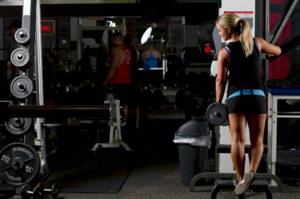
To pump up the calf muscles, it is recommended to exercise 3 times a week for six months.
Before training, be sure to warm up and pay attention to the following rules:
- take short breaks between approaches (1 minute each);
- give regular, systematic physical activity;
- gradually increase the number of approaches and complexity of exercises;
- adhere to the execution technique.
More about anatomy
The gastrocnemius is the name given to the biceps muscle located on the back.
At first glance it may seem like there is only one muscle, but in fact there are two muscles. This misconception is due to the fact that you can see and touch only the upper one, under which is located the second one, called the soleus. It is the muscle “invisible” to the eye that is responsible for volume. Increasing, it affects and, as it were, inflates the upper one. When running and walking, both muscles are used at once. Constant load does not always give the desired result. The main reasons for this may be the following:
- choosing workouts with too low an intensity;
- a similar effect, that is, the absence of volume gain, is achieved by an excess of loads;
- incorrectly selected training.
To correctly compile a set of training, it should be taken into account that the lower one (soleus) is worked out in a sitting position, and the one located above it (superficial) - in a standing position. To get maximum results, you need to use both the lower and upper muscles in the training.
The key to success is not the constant repetition of the same exercises, but hard training with weights. The regularity of classes should be moderate. It is recommended to train once or twice a week, but no more. Otherwise, it will cause overload and the result will be the opposite of the desired one.
The frequency of training should be such that the cardio loads present in the schedule, if any, are carried out before working with iron. It is best to work the calf muscles at the end of a leg workout, and start with the soleus, since it is stronger than the superficial one.
How to reduce calves on your legs
Sometimes it is necessary to reduce the volume of the calf muscles. More often, this problem occurs in women who are actively involved in sports, cycling, running, and athletics. To achieve these goals, stretching the calf muscle will be effective.
It is recommended to sit down, straighten your legs, and pull your toes towards you. Stay in this position as much as possible, return to the starting position and pull your toes away from you. The force load on the lower limbs should be extremely limited. Methods such as cosmetic procedures and diet therapy will also help solve the problem.
Changing dietary principles
No special diet is required to reduce calf muscles. But trainers recommend reconsidering, changing nutritional principles, and reducing the percentage of protein foods in the diet as much as possible. The basis of the daily menu should be fresh vegetables, fruits, herbs, fermented milk products, bran, and grains.

Massage
It will help reduce the volume of calves with swelling or accumulation of subcutaneous fat deposits. For these purposes, both manual, manual, and hardware techniques are used. Massage helps normalize blood circulation, the outflow of blood and lymph, and the breakdown of subcutaneous fat. The number of sessions is determined individually.
Wraps
They also help slim your calves. Hot wraps have a good effect because they:
- raise the local temperature to 38° C;
- stimulate blood circulation;
- activate metabolic processes;
- promote fat burning.
The procedure has contraindications, so it is better to consult a doctor before performing it. It is recommended to have body wraps done in a salon by a good professional, without experimenting with folk recipes.
Injury Prevention
To avoid injury when performing exercises, you should:
- strictly adhere to the execution technique;
- use reliable support;
- avoid excessive loads;
- refuse training for joint diseases during exacerbation, acute infectious, inflammatory processes, general malaise;
- Don’t forget about pre-warming and stretching.
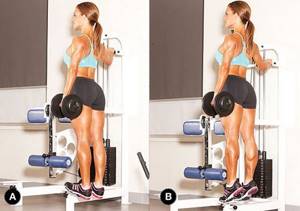
Exercises for the calf muscles, with a reasonable, correct approach, will make your legs slender, toned, strengthen joints and ligaments, and increase the tone of the body.
